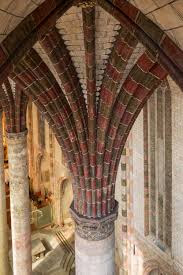The Jacobins' Church.
- Franck BRUGUIERE
- Aug 31, 2023
- 3 min read
Updated: Nov 8

The Church:
Originally, the building was simple, reflecting the humble preaching brothers who lived there.
The facade is very strict, with only a few gargoyles and a door present. Aportal from 1234 is also on the west side.
The building was constructed in the 12th and 13th centuries.
It is a jewel of Languedoc Gothic art, entirely in brick typical of Toulouse.
It was considered the most beautiful Dominican church in Western Europe.
The church consists of a cloister, a chapter house, a refectory and a " Saint-Antonin " chapel.

Initially, it was a building where the Dominican Catholic preaching brothers wanted to bring the good word to the Albigensians, the Cathar heretics according to the King of France.
It measures 80 meters in length and 20 meters in width. The millstone piles are 22 meters high.

The most notable is the construction of tree co-called palm the technique, which is a unique masterpiece in the World, it is 28 meters high.
The church will be extent in the middle of the 13th century, the heart will be raised at the end of that same century, thanks to the palm tree technique.
The bell tower in on the north side of the church and is 45 meters high.
It is an octogonal bell tower with 4 floors.
During the French Revolution, its spire was destroyed.
The nave, however, was raised in the 14th century.
The Jacobins, throughout their history, underwent numerous renovations.
The Cloister:
It is a haven of peace in the heart of the city, when you are there, there is no sound.
Many people from Toulouse come to read, draw, paint, or relax there.
It was constructed over a century between 1230 and 1315 and consists of four galleries.
The colonnades are made of gray Saint-Béat marble and the capitals are adorned with vegetal sculptures.
They support the lean-to roof.

It is located between the refectory and the chapter house.
Built and decorated between 1335 and 1341 at the expense of " Dominique Grima ", Bishop of Pamiers.
Its decoration represents the second vision of the Apocalypse.
Near the white windows with false lily flowers, there are angels, each of them with musical instruments.
The Walls paintings of Saint-Antonin, Bishop of Pamiers.
Since 1369, the church has housed relics of " saint-Thomas D'Aquinas ".
The interior is painted with polychrome decorations and Occitan crosses from Toulouse.
The stained glass windows date back to 1955 and were created by " Max Ingrad ", inspired by Western roses.
The evolution on the Jacobins over time:
The first Empire made it a barracks for the soldiers.
The French Revolution led to the relocation of the religious to Saint-Sernin.
For several centuries, the Jacobins housed the University of Toulouse, but it was relocated during the French Revolution.
In 1908, there was a major political congress of the socialist party, with the great local left-wing politician " Jean Jaurès ".
At the end of the 19th century, an exhibition of arts and industry brought together more than 1 600 craftsmen.
During the first World War, the church served as a hiding place for the treasures of the Paris museums.
In our times:
Today, the Jacobins are very much open to the public.
Catholic Masses are now celebrated there on a small altar in its midst.
In the summer, the Jacobins host temporary exhibitions and after dark, classical music concerts are organized in this wonderful setting.
Above all, there is the annual Jacobins Piano Festival.
The Jacobins Church is a first-rate architectural building in Toulouse.
The Jacobins by night:
The illumination dates back to 1918 and has been improved many times since.
Today, it is illuminated by an eco-friendly LED system.
The lighting is not harsh, but rather gentle, in order to highlight the major architectural elements of the building.
That's all for today.
I hope you will enjoy reading this post dedicated to the Jacobins.
Perhaps this will make you want to come to Toulouse to visit this magnificent building.
Welcome in Toulouse
The Blog from Toulouse.
Greetings Franck.



























Comments